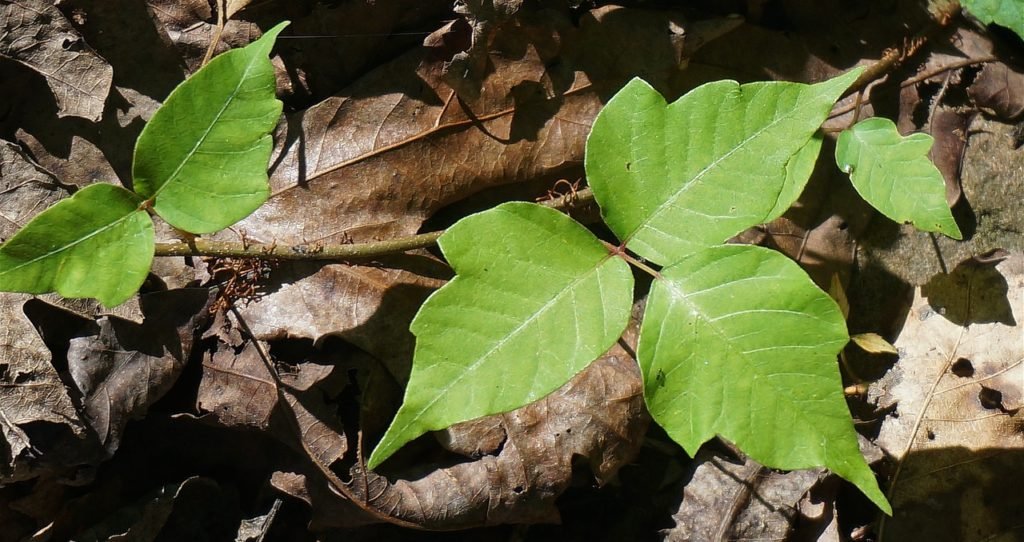
Poison Ivy is a reality of disc golf on many courses. Poison Ivy affects some people more than others. Being able to identify poison ivy, and understanding what to do if you come in contact with it, can mean the difference between weeks of uncomfortable rashes and continuing on as usual. Here’s everything you should consider regarding disc golf and poison ivy.
I’ll say it right away. I’m not a doctor or a botanist or anything remotely approaching an expert in those fields. But, if ever there were a non-doctor, non-botanist expert in the field of poison ivy, it would be me. I was that kid in elementary school covered, head to toe, in poison ivy rashes and uncomfortable blisters. I even found a way to get covered in the dead of winter (I will discuss this as well). Throughout my life, I would say that 4 out of my top 10 most urgent medical concerns have been directly related to this poison ivy.
If there were an infographic of my life, that fiendish 3-leafed spawn of the devil would have to have a place on it (along with a disc or basket).
Pain is a powerful teacher. And as a result, I have learned nearly everything one needs to know about identifying, avoiding, removing, preventing, and treating poison ivy. In this post I pass this knowledge on to you.
I wouldn’t wish this stuff on my worst enemy, and I want to make sure you can learn from my long, storied history with poison ivy so that you can stave it off in your own life. The efforts you make in this regard are well worth the rewards!
Identifying and locating Poison Ivy
“An ounce of prevention is worth a pound of cure,” is a saying that has many applications in life. Poison ivy is one such application.
A rash from this stuff can last up to 2-3 weeks. It can bother you all day and even significantly affect your sleep. If you get it like I do, you won’t want to be playing disc golf for a while either. It’s well worth learning to identify poison ivy so you can prevent it.
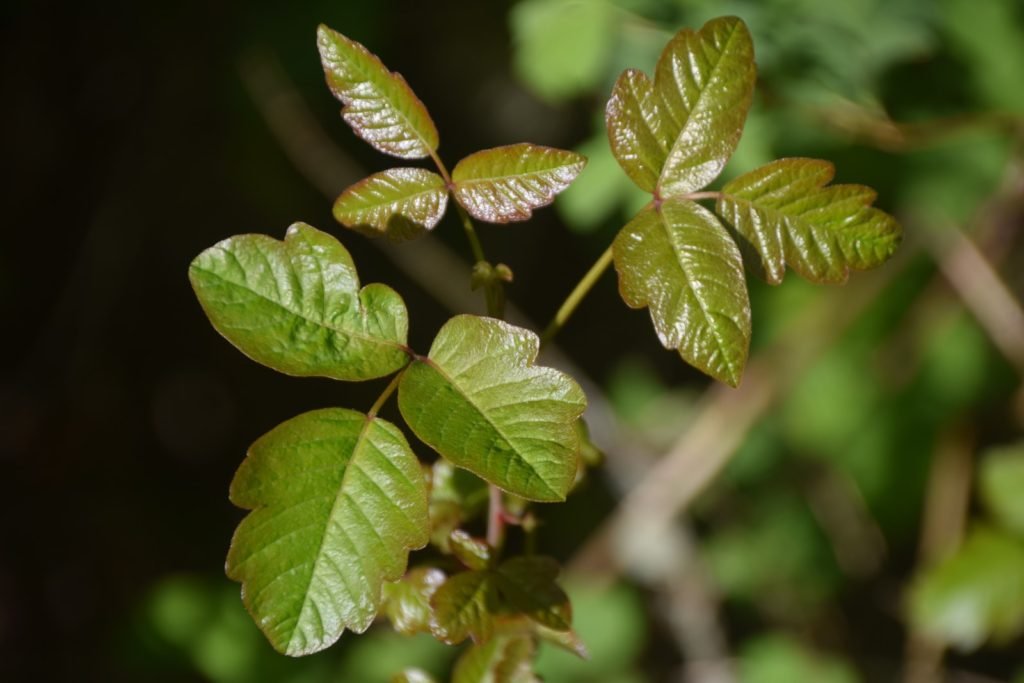
At the basic level, poison ivy comes in clusters of 3 green leaves. It has an oil on it (that’s what causes the rash) so it also usually has a shiny luster to it as well.
Poison ivy can grow up trees, fences, walls and more as vines. It can also grow in patches or clusters, in the woods, fields, sides of roads or more. Most commonly it is found on the edges of forests where it’s roots can rest under the damp leaves and it’s leaves can get full sun. Occasionally, I find a few singular plants just peeking out on their own as well like a snake in the grass.
I will fill this post with pictures, but I think it is well worth a search on google images to get a feel for the different ways poison ivy can present itself.
Given my “rich” history, I can spot poison ivy from a mile away. To me, it has an evil look to look to it. But, to the untrained eye, it could very well look rather tame.
Poison ivy is anything but tame, and my advice, if you are in doubt, is to just treat an unknown plant as if it is poison ivy. If you’re wrong, and it wasn’t poison ivy, it’s only a mild inconvenience. If you’re right, and it was, you might be saving yourself weeks of painful rashes.
How does poison ivy cause rashes?
Poison ivy, as we said above, has an oil on it. This oil is called urushiol which is also found on poison oak and poison sumac. When this oil gets on your skin, and remains there for a designated period of time it can cause a rash ( which varies in severity by person).
How much of the oil and how long it stays on you will affect the severity of your symptoms as well (Read: if you get it on you, remove it asap).
The oil causes an allergic reaction. For some of us it’s a mild irritant, and for others, like me, it can send you to the hospital.
According to some “topical” internet research, about 15% of Americans don’t get a reaction at all. That means 85% of Americans do.
Unless you are absolutely sure that you’re not allergic, it would seem sensible that you act as if you are allergic and get those oils off of you.
You are also going to want to remove the oils from your clothes, discs, or anything that has it on it.
The classic story is the one of the camper that got poison ivy from their sleeping bag that they hadn’t used in years. Those oils are pretty stable and so you’ll want to remove them so you don’t get repeat exposures!
Methods of prevention
So far, we know that if poison ivy touches us, the oil (urushiol), can get on our skin and cause this uncomfortable rash (which varies person to person).
Obviously, if at all possible, we want to completely avoid poison ivy altogether. Therefore being able to identify it and not touch it, is your best bet for prevention.
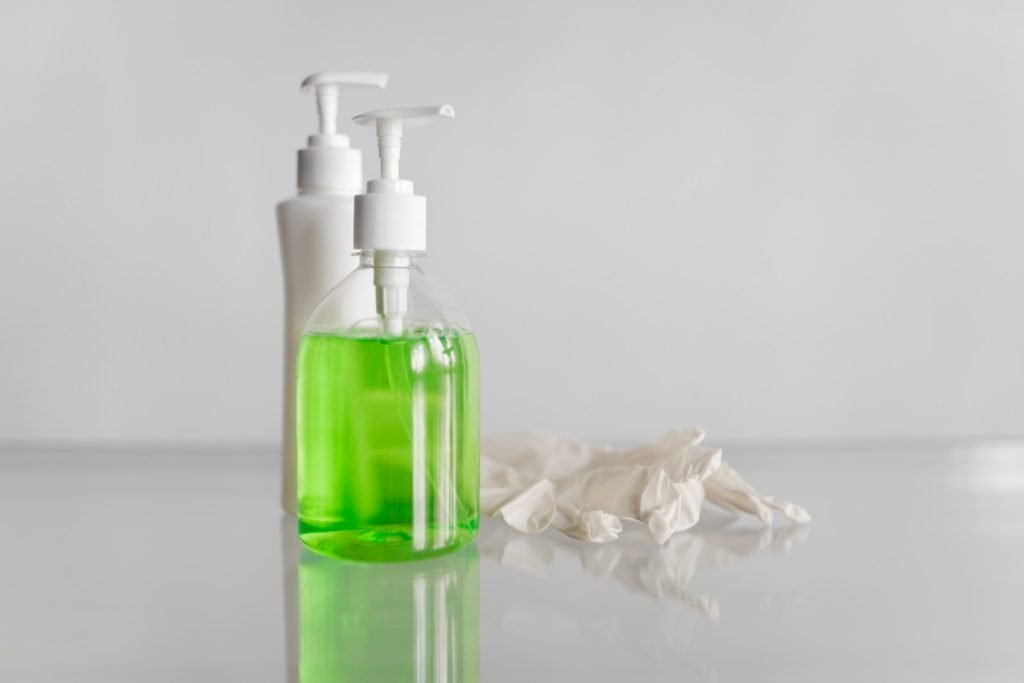
But what if your disc lands in a patch of it? Or maybe you realized too late that you walked through it. What then?
Luckily, this oil can be neutralized rather easily. Think of it like grease on a pan (it’s oil after all). So, with that in mind, use some dish soap (most soaps work for me). Scrub it with the soap nice and good. Then, because it’s worth it, repeat, and wash the area again (can you tell I’m haunted by this stuff?).
Rubbing alcohol and a product called Tecnu also have good buzz. (More on these later). With all products, the idea is to neutralize/remove the poison ivy oils ASAP.
Objects that come in contact with poison ivy
This poison ivy oil can get on all sorts of materials and objects in your life. Then, because it lasts a long time, it can come back and haunt you later.
For our purposes, some of the more common objects that we might be dealing with are clothes and discs (but please don’t put your bag down in poison ivy).
Basically, that oil can transfer from the objects to your skin. So, to prevent this, we need to remove the oils from all objects that may have the urushiol on it.
If I walk through the stuff, I make sure not to touch my shoes or pants for the rest of the day. Then, I undress right next to the washing machine, toss all my clothes in (including my shoes. Side note, but also a nice life hack for most athletic shoes. Putting running shoes in the washing machine, followed by drying in the sun gets them good as new!), and immediately wash my hands (to get oils off). Finally I hop right in the shower and get scrubbing with soap.
For discs that land in PI, I spray them with rubbing alcohol (which annoyingly removes my permanent marker) and/or quarantine them in a separate part of my bag, not to be used again for the rest of the round. Then, once home, I wash them with soap and water. I also spray the bag where it stored the disc with alcohol spray as well btw.
Side story: Back when I played my first stint in disc golf, I was most likely the person responsible for a “Please don’t wash your discs in the sink,” sign on the mirror at a certain course in Massachusetts. This would have been circa 2013. If you ever saw those, let me know!
Naturally, I wanted to respond with “I’ll stop washing as soon as you get rid of all this effing poison ivy!” But I didn’t have anything to write with so I just let it pass.
Side story over.
Remember, anything that gets the oil on it, has the oil on it until you remove it. Get that oil off as soon as you can and prevent the spread of it!
How Long do you have to remove Poison Ivy Oils?
This is a great question and one I’ve often pondered myself! Interestingly, the rash itself doesn’t start to form until 12 hours to 48 hours after exposure. This makes it difficult to know for sure how long you have to wash it off. The annoying answer is that it probably varies person to person.
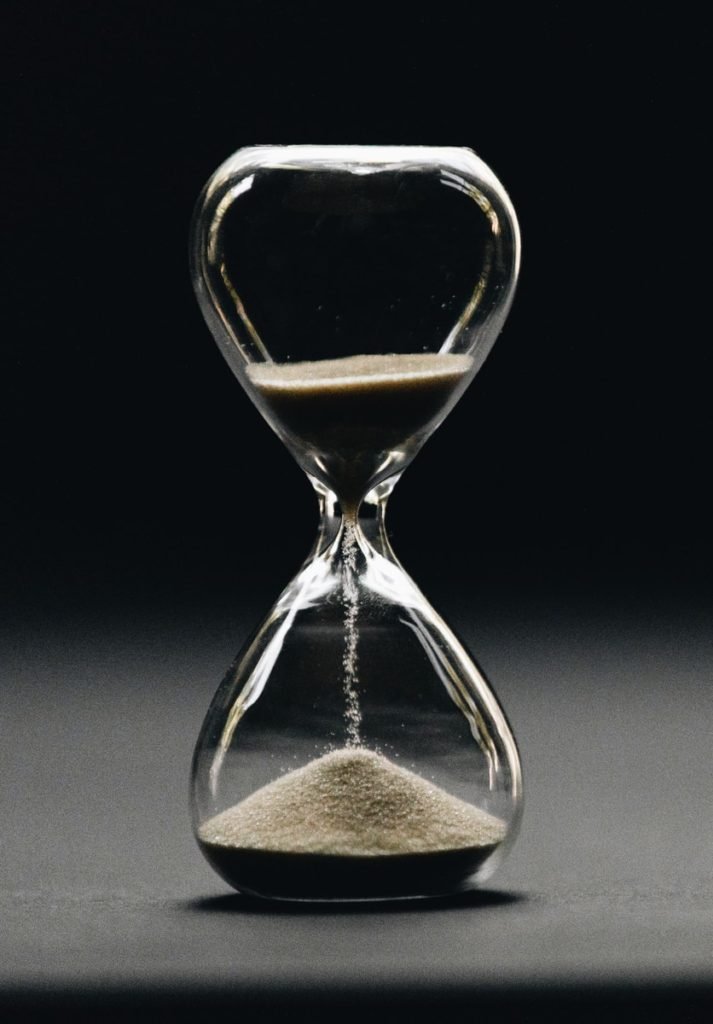
And looking online I see everything from 15 minutes to 2 hours.
In my head, I always want to get it off ASAP obviously, but that’s not always possible. If I touched it I usually have an hour before I get stressed at all. The 2 hour point is where the anxiety goes up a bit.
This guy, in the video below, ran an experiment on just this question. I used to always like these human experiment types. I remember reading about Neil Noakes in college. He gave himself bacteria that causes ulcers in order to prove that bacteria causes ulcers.
Morgan Spurlock (the Super Size Me guy) was also famous for this, and had a lot of great content (but he also canceled himself and hasn’t recovered since).
Back to our friend below! He rubbed poison ivy on specific parts of his arm and washed it off at various intervals after exposure (15 min, 30 min, 1 hour, 2 hours, 4 hours, 6 hours and 10 hours).Then he gives us the results.
Give it a watch and thank him for his contribution to science by hitting the like! It’s also beneficial because you can see what the poison ivy plant looks like and view some of the nasty rashes as well.
Results: Basically, he definitely got a rash at the 4-hour mark. And in essence, he didn’t get anything of consequence anywhere from 15 minutes to 2 hours.
This matches what I have in my head pretty well (but I don’t know for sure). Wash that oil off before 2 hours and you will seriously diminish its potency.
In the bag! Poison ivy prevention
For me, this is absolutely non-negotiable. I always make sure that I am packing my bag with some form of poison ivy combatant!
And just a quick disclaimer here. I’m not running my own experiments on the molecular level here. I’m just curating the best information that I have found. As a result, I have not gotten poison ivy myself in a long time, and that’s why I’m passing it on to you. Do your own research too, if it makes you feel better.
Here are the 3 products to consider taking with you in your disc golf bag:
PI Preventer #1 – Soap
A little container of liquid soap (like Dr. Bronner’s for example) is a must have in any of my bags. Then, if I am exposed (or even suspect I might be exposed) I simply wash the skin and I can even wash the disc. Usually, I have some bottled water with me or there is a pond/stream near by. That makes it easy to simply wash off the soap and continue on with my round without that nagging feeling that the clock is ticking.
PI Preventer #2 – Rubbing Alcohol
If I have to reach in to grab my disc from a batch of poison ivy (or even if I suspect my disc plowed through some of it) then it’s nice to have a small spray bottle of rubbing alcohol on hand.
If I have that oil on my hand I’m worried I’ll inadvertently touch some other part of my face as well.
I can spray the alcohol on my hand, AND, if I have already touched my phone, I can spray it on the phone to make sure there are no oils lingering.
Remember: Many of us have a lot of these hand sanitizer bottles readily available. At the start of the pandemic those things were all the rage! Just grab an unused bottle and pop it in your bag.
Warning: Do not leave the alcohol bottles in a hot car! They are known to explode! But really, you shouldn’t be leaving your plastic discs in a hot car on the regular either so it works out!
PI Preventer #3 – Tecnu
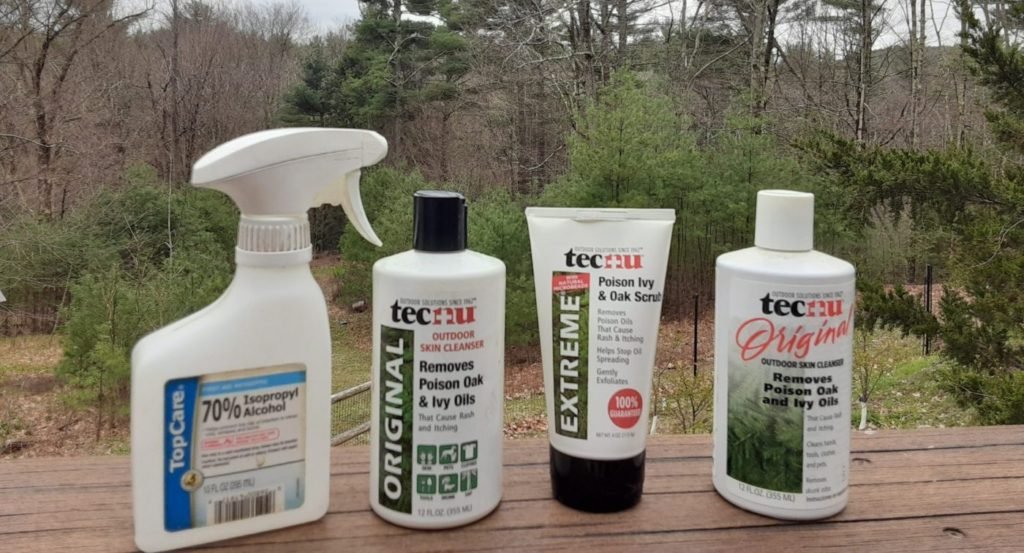
This product is my least favorite of the 3 options when it comes to disc golf. But it’s also the only product specifically designed to neutralize poison ivy oils, so I like to have some on hand.
Here’s how I use Tecnu: Basically, I leave Tecnu behind in my car. It’s got an oily feel to it which doesn’t jive well with throwing discs. I’m also not a huge fan of the smell. Click here to buy it! Ha!
But if, like me, you are in that rarefied air (it’s nice to feel special), where poison ivy has the ability to ruin the next 3 weeks of your life, then you’ll want to have this stuff as a back-up plan, for when you get back to your car.
Just spread it over any skin that you think might be exposed and then you can feel good that whatever oils it has come in contact with are neutralized. This peace of mind is nice to have when you still have a 45 minute drive before you get to a shower.
Remember: After your round, always wash anything that might have the oil on it, and then hop in the shower and soap/scrub all over (with cooler water. I’ve read that the hot water can open your pores and allow the oil in). I’m always paranoid that I inadvertently touched the oils and then spread them elsewhere (And don’t worry, I already have a therapist) so I always shower after I’ve been exposed.
This way I can feel good that I’ve gotten rid of any lingering oils and can start fresh with a clean slate!
And while you’re doing all this work: Check for ticks as well! You’re already in the shower so give yourself a once over and make sure those ticks are off you too. If you are anything like me as a disc golfer then you are doing A LOT of bushwhacking right where the ticks reside!
Other Random Considerations with Poison Ivy
I have just a few more tidbits of information that I’d like to pass your way just to make sure you can stay as free of this stuff as humanly possible!

Autumn Coloring – In the fall as the leaves change color in preparation for winter, poison ivy does the same! Usually it will turn a pale yellow or red color. Be on the look out for it, so you don’t get in trouble!
Avoid Brush Fires! – This one is scary! Poison ivy can go air born when burnt! And I don’t have great confidence that all these people burning brush can properly identify poison ivy. Neither should you. So, when every body is burning their brush in the fall, I make sure to stay well clear of their smoke. Better safe than sorry!
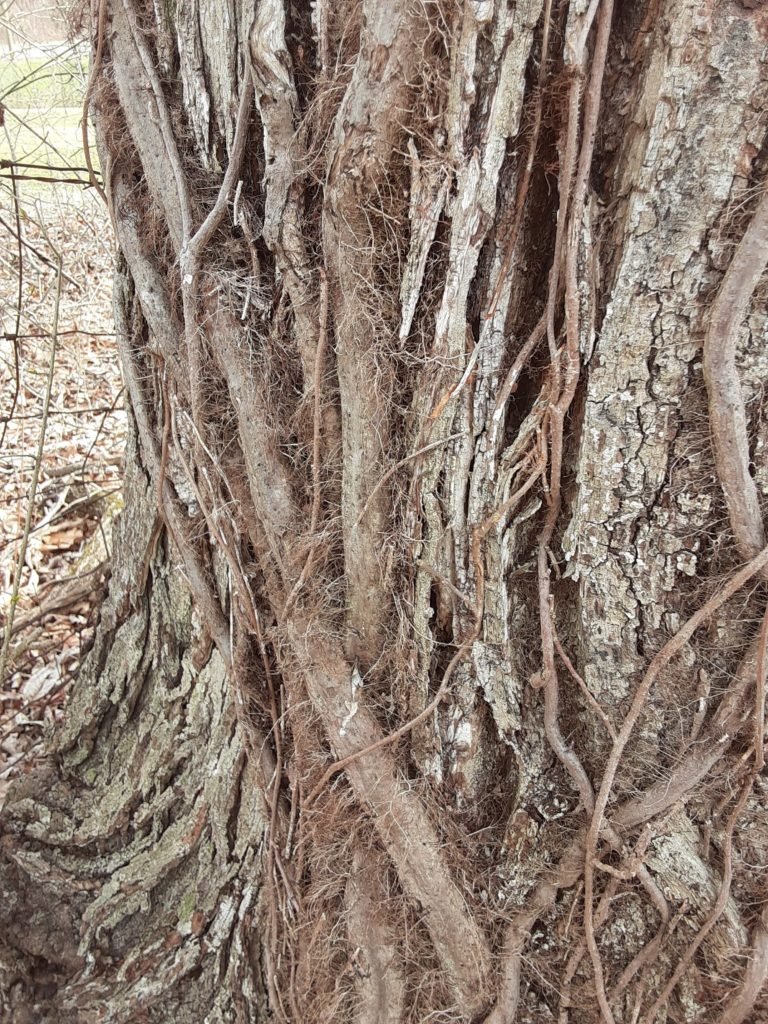
Winter Vines – We’ve already established that poison ivy grows up trees/walls/fences in the winter. And in winter, the leaves do disappear, but the vines stay put. And, as you might have guessed, the vines have plenty of the oil as well. Just as my 5th grade self going into school completely covered in January (rather perplexing/hilarious to even my teachers!)
Luckily the vines are pretty easily recognizable once you know what to look for. Basically they tend to be think and very hairy looking. I took a picture at one of my local courses that I played in April before the leaves came back out. Have a look!
Treating Poison Ivy Rash
Honestly, the best treatment is to just not get it. That’s why I’ve put such a heavy emphasis on the prevention aspect of this post.
Do oatmeal baths, menthol creams, hydrocortisone creams or that pink crap (calamine lotion) work? Perhaps. I can’t say it doesn’t but I haven’t found any miraculous treatments either. And believe me, I’ve tried it all. If I did find relief, it was only a mild dissipation of the symptoms. No matter what I tried, I still couldn’t sleep well or even move all that well for a few weeks.
I’ve even been prescribed oral corticosteroids at the hospital as one doctor (no joke) literally recruited other doctors to have a look at the mess I had gotten myself into. They stood over me inspecting me and debating what the heck should be done.
My honest, no BS, hard knocks, opinion is this: Don’t get this stuff on you! Avoid it and wash it off as soon as you even suspect you might have been exposed.
But as I said, most people don’t get it as harshly as I do (lucky me). That being said, if you do have a “can’t miss” remedy for treating it, I’d love to hear about it in the comments below.
In Summary: Disc Golf and Poison Ivy
In summary, we’ve established a lot of information to help prevent this potent irritant from affecting our lives.
We know that the oil, urushiol, is what causes the reaction and that we have to prevent this oil from touching our skin.
We don’t know for sure, but we think that 2 hours is about the maximum that you can have it on your skin before you start to form a rash (though this most likely varies person to person and I recommend removing it ASAP).
Here’s a quick review of the steps we established to keep it out of your life:
First, be able to identify it so that you can avoid it at all costs.
Second, if you think you were exposed, neutralize the oils on your skin as best you can on the spot. To do this make sure you carry soap, rubbing alcohol and/or Tecnu in your bag.
Also, make sure you either 1. don’t touch, or 2. wash any objects that might have come in contact with the oil.
Third, When you get home, wash all items (including clothing) that could have the oil on it.
Finally, hop in the shower and scrub well with soap and cooler water. Then, do it again just to be sure!
There are no guarantees in this world, but if you follow those steps, I seriously like your chances of preventing this vicious plant from negatively impacting your life.
And with those extra weeks you just saved, you can head outside and keep disc golf’n around!
Thanks for reading everyone. I sincerely hope that you have found this helpful. If you have any thoughts/questions please feel free to comment below. Also, I’m open to hearing about any experiences you’ve had with the stuff or any remedies that you’ve found to be helpful! Reach out and contact me any time and go ahead and subscribe while you are there as well. In the meantime, enjoy disc golf’n around poison ivy free!


Comments are closed.